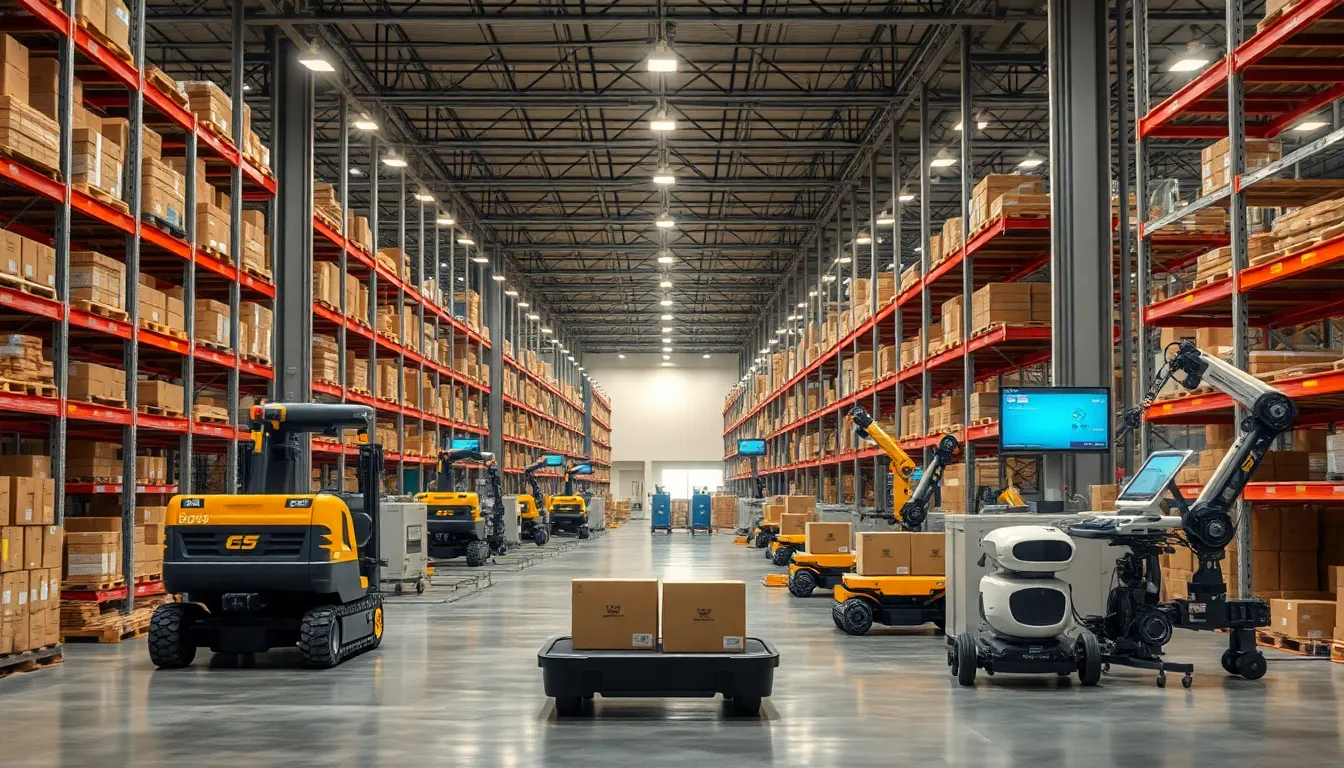In a world where even your coffee maker seems smarter than your last date, warehouse robotics is leading the charge into the future of logistics. These high-tech marvels are not just glorified vacuum cleaners; they’re the unsung heroes behind the scenes, tirelessly zipping around warehouses like caffeinated squirrels on a mission. As businesses scramble to keep up with demand, automation is no longer a luxury—it’s a necessity.
Imagine a warehouse where robots handle the heavy lifting, leaving humans to focus on strategy and creativity. It’s like turning your chaotic kitchen into a Michelin-star restaurant, all thanks to a few clever gadgets. With efficiency soaring and costs plummeting, embracing warehouse robotics could be the game-changer every business needs. So, buckle up and get ready to explore how these mechanical wonders are revolutionizing the way we store and distribute goods.
What Is Warehouse Robotics?
Warehouse robotics refers to the use of automated machines in storage and distribution centers. These machines streamline processes by performing tasks that range from transporting items to picking and packing products.
Robots equipped with advanced sensors and AI algorithms improve accuracy and speed. High-capacity systems, like automated guided vehicles (AGVs) and robotic arms, handle heavy items efficiently. These innovations minimize human strain during physically demanding tasks, which allows employees to focus on more complex duties.
Integration of warehouse robotics directly enhances operational efficiency. A recent study indicated that businesses employing robotics can see up to a 20% increase in productivity. Automated systems reduce errors in inventory management, leading to higher customer satisfaction rates.
Warehouse robotics also contribute to cost savings. The initial investment may seem significant, but reduced labor costs and increased throughput often offset this expense within a few years. Many warehouses experience faster shipping times, ensuring customers receive products without delays.
Collaborative robots, or cobots, are designed to work alongside human workers safely. These systems adapt to various tasks, making them versatile assets in fast-paced environments. Companies often choose cobots for their flexibility and ability to enhance human labor rather than replace it.
Technological advancements continually shape the warehouse robotics landscape. Emerging innovations, such as machine learning and improved robotics, drive ongoing improvements in efficiency and reliability. As businesses adopt these systems, they position themselves to meet future market demands effectively.
Types Of Warehouse Robotics

Warehouse robotics encompasses various automated systems designed to enhance logistics efficiency. Understanding these types helps businesses select the right solutions for their operations.
Automated Guided Vehicles (AGVs)
Automated Guided Vehicles (AGVs) navigate through warehouses autonomously. Equipped with sensors and cameras, they transport goods between specific locations. Many AGVs follow predetermined paths, optimizing routes for speed and safety. They operate in diverse environments, from manufacturing plants to distribution centers, delivering items without human intervention. Implementing AGVs can lead to a significant reduction in operational costs, sometimes exceeding 30% in some scenarios.
Robotic Arms
Robotic arms perform complex tasks such as picking, sorting, and assembly in warehouses. With advanced capabilities, these machines handle a variety of objects, from delicate products to heavy packages. Significant precision and speed characterize their operations. Many robotic arms use machine learning algorithms to improve performance over time, adapting to different tasks as needed. Their implementation can enhance productivity rates by up to 25%, making them essential for modern warehousing.
Mobile Robots
Mobile robots facilitate quick and flexible operations in warehouses. Designed for dynamic environments, they move autonomously among various workstations and can adapt to changes in their surroundings. Often equipped with AI, these robots can communicate with each other to optimize workflow, streamlining logistics processes. Mobile robots contribute to improved order accuracy and can process inventory updates in real-time. Deploying these systems can lead to a remarkable increase in efficiency, with some companies reporting up to 40% enhancements in throughput.
Benefits Of Warehouse Robotics
Warehouse robotics significantly enhance operational productivity across various industries.
Increased Efficiency
Automation leads to improved speed and accuracy in warehouses. Robots execute tasks like picking and packing at a pace unmatched by human workers. Moreover, studies show a potential productivity increase of 20% when implementing robotic solutions. High-capacity systems like Automated Guided Vehicles facilitate efficient transport between locations, reducing transit times. Tasks once requiring multiple personnel can now be completed faster and with fewer errors. Robots equipped with advanced sensors efficiently manage inventory and streamline processes. Overall, it’s evident that robotics transforms operations into more efficient systems.
Cost Reduction
Cost savings emerge as a major advantage of warehouse robotics. Automation minimizes labor costs and increases throughput, enabling businesses to offset initial investments within a few years. For example, AGVs can potentially reduce operational costs by over 30% due to their ability to operate continuously without breaks. Additionally, decreased error rates in order fulfillment help prevent costly mistakes, further enhancing the bottom line. The overall reduction in labor needs allows companies to allocate resources effectively. Cost-efficient operations support businesses in navigating competitive markets.
Enhanced Safety
Warehouse robotics contribute significantly to workplace safety. Robots take over heavy lifting and dangerous tasks, reducing the risk of injury for human workers. By minimizing the need for manual handling of hazardous materials, organizations lower workplace accidents. Collaborative robots are designed to work beside humans, offering safer environments while enhancing productivity. Improved safety records assist businesses in maintaining compliance with regulations. Additionally, decreased injuries lead to lower insurance costs, further benefiting overall operational budgets. Thus, the integration of robotics fosters safer and more compliant workplaces.
Challenges In Implementing Warehouse Robotics
Implementing warehouse robotics poses several challenges that can impact efficiency and overall success.
High Initial Investment
High initial investment remains a significant barrier for many organizations considering robotics. Automation systems typically require substantial upfront funding for equipment, software, and infrastructure. Many businesses face difficulty justifying these costs, especially when budgets are tight. Although some studies show a potential return on investment within a few years, this timeline can vary greatly between industries. Decision-makers often grapple with the uncertainty of future market conditions, which may influence their willingness to invest in advanced technologies.
Integration With Existing Systems
Integration with existing systems can create challenges during the implementation of robotics. Many warehouses operate using legacy technology, which may complicate communication between new robotic systems and traditional equipment. A lack of compatibility can lead to operational disruptions and inefficiencies. Additionally, training staff to work with new robotics might require dedicated time and resources. Successful integration emphasizes the need for thorough planning and testing before full implementation. Organizations must prioritize seamless integration to realize the full benefits of automation while minimizing potential setbacks.
Future Trends In Warehouse Robotics
Warehouse robotics is advancing rapidly, driven by technological improvements and evolving market needs. These trends aim to enhance efficiency and flexibility within logistics operations.
Advancements In AI And Machine Learning
Improvements in artificial intelligence and machine learning are reshaping warehouse robotics. Enhanced algorithms enable robots to learn from real-time data. This capability allows them to optimize routes and adjust to changing environments, increasing productivity by 20%. Innovative data processing also drives accurate forecasting for inventory management. AI-equipped robots reduce errors and enhance decision-making processes, streamlining workflows considerably. Companies adopting these technologies can expect significant gains in operational efficiency, making their logistics operations more responsive and adaptable.
Collaborative Robotics
Collaborative robots are becoming integral to warehouse environments, emphasizing teamwork between machines and human workers. Designed to support rather than replace humans, these robots enhance productivity by performing repetitive tasks. Flexibility characterizes collaborative robots, allowing for easy reprogramming and movement between different tasks. Companies report a 25% increase in efficiency after integrating cobots into their operations. Safety features ensure that these robots work alongside humans without causing accidents, fostering a proactive work atmosphere. As warehouses adopt collaborative robotics, they improve workflow and empower employees to focus on higher-value tasks.
Warehouse robotics is revolutionizing the logistics sector by enhancing efficiency and safety while reducing costs. As companies embrace these technologies they’re not only meeting growing demands but also positioning themselves for future success. The integration of advanced robotics allows for greater accuracy and faster operations which are crucial in today’s competitive market.
While challenges like initial investment and integration with existing systems exist the benefits far outweigh the hurdles. As the industry continues to evolve with ongoing advancements in AI and machine learning the potential for increased productivity and improved workplace safety will only grow. Embracing warehouse robotics is no longer just an option; it’s becoming essential for businesses aiming to thrive in an increasingly automated world.






